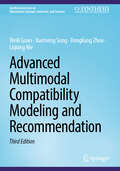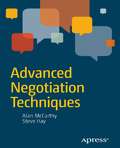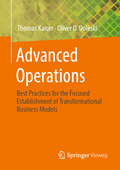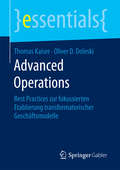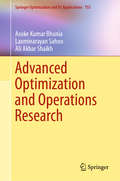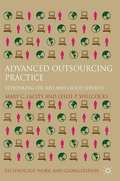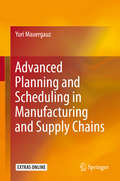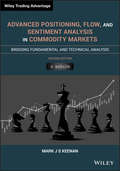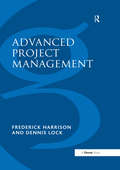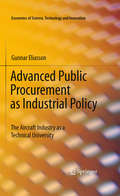- Table View
- List View
Advanced Microeconomic Theory: An Intuitive Approach with Examples
by Felix Munoz-GarciaAn introduction to advanced topics in microeconomics that emphasizes the intuition behind assumptions and results, providing examples that show how to apply theory to practice.This textbook offers an introduction to advanced microeconomic theory that emphasizes the intuition behind mathematical assumptions, providing step-by-step examples that show how to apply theoretical models. It covers standard topics such as preference relations, demand theory and applications, producer theory, choice under uncertainty, partial and general equilibrium, monopoly, game theory and imperfect competition, externalities and public goods, and contract theory; but its intuitive and application-oriented approach provides students with a bridge to more technical topics. The book can be used by advanced undergraduates as well as Masters students in economics, finance, and public policy, and by PhD students in programs with an applied focus.The text connects each topic with recent findings in behavioral and experimental economics, and discusses these results in context, within the appropriate chapter. Step-by-step examples appear immediately after the main theoretical findings, and end-of chapter exercises help students understand how to approach similar exercises on their own. An appendix reviews basic mathematical concepts. A separate workbook, Practice Exercises for Advanced Microeconomic Theory, offers solutions to selected problems with detailed explanations. The textbook and workbook together help students improve both their theoretical and practical preparation in advanced microeconomics.
Advanced Microeconomics for Contract, Institutional, and Organizational Economics
by W. Bentley MacLeodA graduate textbook on microeconomics, covering decision theory, game theory, and the foundations of contract theory, with a unique focus on the empirical.This graduate-level text on microeconomics, covering such topics as decision theory, game theory, bargaining theory, contract theory, trade under asymmetric information, and relational contract theory, is unique in its emphasis on the interplay between theory and evidence. It reviews the microeconomic theory of exchange &“from the ground up,&” aiming to produce a set of models and hypotheses amenable to empirical exploration, with particular focus on models that are useful for the study of contracts, institutions, and organizations. It explores research that extends price theory to the exchange of commodities when markets are incomplete, discussing recent developments in the field. Topics covered include the relationship between theory and evidence; decision theory as it is used in contract theory and institutional design; game theory; axiomatic and strategic bargaining theory; agency theory and the class of models that are considered to constitute contract theory, with discussions of moral hazard and trade with asymmetric information; and the theory of relational contracts. The final chapter offers a nontechnical review that provides a guide to which model is the most appropriate for a particular application. End-of-chapter exercises help students expand their understanding of the material, and an appendix provides brief introduction to optimization theory and the welfare theorem of general equilibrium theory. Students are assumed to be familiar with general equilibrium theory and basic constrained optimization theory.
Advanced Microeconomics: Theory, Applications and New Developments
by Bibhas SahaAdvanced Microeconomics presents microeconomic problems in an intuitive way. Using lucid narratives to build on students’ initial understanding of economics and economic reality, equations and diagrams are incorporated to provide accessibility to students with a basic level of calculus to reach precise quantitative answers. It covers the standard areas of microeconomics such as consumer theory, producer theory, economics of uncertainty, general equilibrium and markets.The book also includes new developments such as behavioural economics, prospect and regret theory, public-sector firms, bargaining, signalling games, adverse selection and moral hazard. Real-life applications are given throughout the chapters, clearly showing students how the advanced theory connects to the real world. Each chapter provides a set of exercises for independent problem-solving. Learning is also supported by lists of key terms, chapter summaries and further reading suggestions. Advanced technical materials are presented in optional appendices. Digital supplements include quiz questions, solutions to exercises and instructor materials. The flexible chapter sequencing in the book enables instructors to create their preferred syllabus.Developing students’ intuitive appreciation for the theory as well as mathematical analysis, this is the ideal textbook for microeconomics courses at master’s level (MSc and MRes) and advanced undergraduate level.
Advanced Modelling in Mathematical Finance: In Honour of Ernst Eberlein (Springer Proceedings in Mathematics & Statistics #189)
by Jan Kallsen Antonis PapapantoleonThis Festschrift resulted from a workshop on "Advanced Modelling in Mathematical Finance" held in honour of Ernst Eberlein's 70th birthday, from 20 to 22 May 2015 in Kiel, Germany. It includes contributions by several invited speakers at the workshop, including several of Ernst Eberlein's long-standing collaborators and former students. Advanced mathematical techniques play an ever-increasing role in modern quantitative finance. Written by leading experts from academia and financial practice, this book offers state-of-the-art papers on the application of jump processes in mathematical finance, on term-structure modelling, and on statistical aspects of financial modelling. It is aimed at graduate students and researchers interested in mathematical finance, as well as practitioners wishing to learn about the latest developments.
Advanced Multimodal Compatibility Modeling and Recommendation (Synthesis Lectures on Information Concepts, Retrieval, and Services)
by Liqiang Nie Xuemeng Song Weili Guan Dongliang ZhouThis Third Edition sheds light on state-of-the-art theories and practices in multimodal compatibility modeling and recommendation, offering comprehensive insights into this evolving field. This topic, and fashion compatibility modeling in particular, has garnered increasing research attention in recent years due to the significant economic impact of e-commerce. Building upon recent research and the prior edition, the authors present a series of graph-learning based multimodal compatibility modeling schemes, all of which have been proven to be effective over several public real-world datasets. This book introduces a number of advanced multimodal compatibility modeling and recommendation methods, including category-guided multimodal compatibility modeling and try-on-guided multimodal compatibility modeling. The authors also provide comprehensive solutions, including correlation-oriented graph learning, modality-oriented graph learning, unsupervised disentangled graph learning, partially supervised disentangled graph learning, and metapath-guided heterogeneous graph learning.
Advanced Negotiation Techniques
by Alan Mccarthy Steve HayAdvanced Negotiation Techniques provides a wealth of material in a winning combination of practical experience and good research to give you a series of tools, techniques, and real-life examples to help you achieve your negotiation objectives. For 25 years and across 40 countries, the Resource Development Centre (RDC), run by negotiation experts Alan McCarthy and Steve Hay, has helped thousands of people to conduct successful negotiations of every type. Many RDC clients have been business professionals who have learned how to sell more successfully. Others have improved their buying skills. A few clients have applied the RDC techniques outside the business environment altogether--for instance, in such areas as international diplomatic services, including hostage and kidnap situations. As you'll discover, the RDC philosophy is centered on business ethics and a principled approach to negotiation that maximizes the value of the outcomes for both parties. It can even create additional value that neither party could find in isolation. In this book, you will learn: The ten golden rules for successful negotiationsHow to handle conflicts with your negotiating partnersWhat hostage and kidnapping negotiations can teach managers negotiating in business settingsHow to ensure both sides perceive any agreement as a 'win'Achieve higher-profit deals in difficult circumstancesIn the business world, negotiating with other companies, government officials, and even your colleagues is a fact of life. Advanced Negotiation Techniques takes you through a system for planning and conducting negotiations that will enable you and your team to achieve your negotiation objectives. This is an internationally tried and tested process, with many current Blue Chip organizations applying it daily for a simple reason: the techniques are easy to implement and they work. That makes this book essential reading for those who want to achieve their goals in any area of life.
Advanced Operations: Best Practices for the Focused Establishment of Transformational Business Models (essentials)
by Thomas Kaiser Oliver D. DoleskiIn this book, Thomas Kaiser and Oliver D. Doleski present a practical management method for the realization of data technology innovations (advanced analytics) as well as a procedure based on this method for the corresponding transformation of business models – which is the pathway to advanced operations. The authors provide assistance with the careful combination of use cases to achieve holistic business objectives. According to this approach, strategic options, structures and methods should accompany the phase of an early transformation. This calls for a system of business model innovation under the perspective of implementing such an Advanced Operations as introduced by this book.
Advanced Operations: Best Practices zur fokussierten Etablierung transformatorischer Geschäftsmodelle (essentials)
by Thomas Kaiser Oliver D. DoleskiThomas Kaiser und Oliver D. Doleski stellen in diesem essential eine praxisbezogene Managementmethode zur Umsetzung datentechnologischer Innovationen (Advanced Analytics) und ein darauf aufbauendes Vorgehen zur entsprechenden Transformation von Gesch#65533;ftsmodellen vor - erst auf diese Weise entsteht eine Advanced Operations. Die Autoren geben Hilfestellung bei der sorgf#65533;ltigen Verkn#65533;pfung von Anwendungsf#65533;llen zu ganzheitlichen, unternehmerischen Zielen. So sollten auch strategische Optionen, Strukturen und Methoden bereits die Phase einer fr#65533;hen Transformation begleiten. Diese ben#65533;tigt die Systematik der darauf aufbauenden Gesch#65533;ftsmodellinnovation mit der Perspektive der Realisierung einer mit diesem essential eingef#65533;hrten Advanced Operations.
Advanced Optimization and Operations Research (Springer Optimization and Its Applications #153)
by Asoke Kumar Bhunia Laxminarayan Sahoo Ali Akbar ShaikhThis textbook provides students with fundamentals and advanced concepts in optimization and operations research. It gives an overview of the historical perspective of operations research and explains its principal characteristics, tools, and applications. The wide range of topics covered includes convex and concave functions, simplex methods, post optimality analysis of linear programming problems, constrained and unconstrained optimization, game theory, queueing theory, and related topics. The text also elaborates on project management, including the importance of critical path analysis, PERT and CPM techniques. This textbook is ideal for any discipline with one or more courses in optimization and operations research; it may also provide a solid reference for researchers and practitioners in operations research.
Advanced Optimization by Nature-Inspired Algorithms (Studies in Computational Intelligence #720)
by Omid Bozorg-HaddadThis book, compiles, presents, and explains the most important meta-heuristic and evolutionary optimization algorithms whose successful performance has been proven in different fields of engineering, and it includes application of these algorithms to important engineering optimization problems. In addition, this book guides readers to studies that have implemented these algorithms by providing a literature review on developments and applications of each algorithm. This book is intended for students, but can be used by researchers and professionals in the area of engineering optimization.
Advanced Outsourcing Practice
by Leslie P. Willcocks Mary C. LacityA rich database of over 2,200 outsourcing arrangements, studied across sectors and geographies, and over time, from inception, through contract signing, to outcomes. This book has unparalleled insight into the robust practices that have been proven effective time and again.
Advanced Placement Economics: Microeconomics, Student Resource Manual
by Gary StoneAdvanced Placement 4th Edition Microeconomics Student Manual
Advanced Placement Economics: Student Activities (3rd edition)
by John S. Morton Rae Jean B. GoodmanAdvanced Placement Economics prepares high school students for their AP Economics Exam.
Advanced Planning and Scheduling in Manufacturing and Supply Chains
by Yuri MauergauzThis book is a guideto modern production planning methods based on new scientific achievementsand various practical planning rules of thumb. Several numerical examplesillustrate most of the calculation methods, while the text includes a set ofprograms for calculating production schedules and an example of a cloud-basedenterprise resource planning (ERP) system. Despite the relatively large numberof books dedicated to this topic, Advanced Planning and Scheduling is the firstbook of its kind to feature such a wide range of information in a single work,a fact that inspired the author to write this book and publish an Englishtranslation. This work consists oftwo parts, with the first part addressing the design of reference andmathematical models, bottleneck models and multi-criteria models and presentingvarious sample models. It describes demand-forecasting methods and alsoincludes considerations for aggregating forecasts. Lastly, it providesreference information on methods for data stocking and sorting. The second partof the book analyzes various stock planning models and the rules of safetystock calculation, while also considering the stock traffic dynamics in supplychains. Various batch computation methods are described in detail, whileproduction planning is considered on several levels, including supply planningfor customers, master planning, and production scheduling. This book can beused as a reference and manual for current planning methods. It is aimed atproduction planning department managers, company information systemspecialists, as well as scientists and PhD students conducting research inproduction planning. It will also be a valuable resource for students atuniversities of applied sciences.
Advanced Portfolio Management: A Quant's Guide for Fundamental Investors
by Giuseppe A. PaleologoYou have great investment ideas. If you turn them into highly profitable portfolios, this book is for you. Advanced Portfolio Management: A Quant’s Guide for Fundamental Investors is for fundamental equity analysts and portfolio managers, present, and future. Whatever stage you are at in your career, you have valuable investment ideas but always need knowledge to turn them into money. This book will introduce you to a framework for portfolio construction and risk management that is grounded in sound theory and tested by successful fundamental portfolio managers. The emphasis is on theory relevant to fundamental portfolio managers that works in practice, enabling you to convert ideas into a strategy portfolio that is both profitable and resilient. Intuition always comes first, and this book helps to lay out simple but effective "rules of thumb" that require little effort to implement and understand. At the same time, the book shows how to implement sophisticated techniques in order to meet the challenges a successful investor faces as his or her strategy grows in size and complexity. Advanced Portfolio Management also contains more advanced material and a quantitative appendix, which benefit quantitative researchers who are members of fundamental teams. You will learn how to: Separate stock-specific return drivers from the investment environment’s return drivers Understand current investment themes Size your cash positions based on Your investment ideas Understand your performance Measure and decompose risk Hedge the risk you don’t want Use diversification to your advantage Manage losses and control tail risk Set your leverage Author Giuseppe A. Paleologo has consulted, collaborated, taught, and drank strong wine with some of the best stock-pickers in the world; he has traded tens of billions of dollars hedging and optimizing their books and has helped them navigate through big drawdowns and even bigger recoveries. Whether or not you have access to risk models or advanced mathematical background, you will benefit from the techniques and the insights contained in the book—and won't find them covered anywhere else.
Advanced Portfolio Optimization: A Cutting-edge Quantitative Approach
by Dany CajasThis book is an innovative and comprehensive guide that provides readers with the knowledge about the latest trends, models and algorithms used to build investment portfolios and the practical skills necessary to apply them in their own investment strategies. It integrates latest advanced quantitative techniques into portfolio optimization, raises questions about which alternatives to modern portfolio theory exists and how they can be applied to improve the performance of multi-asset portfolios. It provides answers and solutions by offering practical tools and code samples that enable readers to implement advanced portfolio optimization techniques and make informed investment decisions. Portfolio Optimization goes beyond traditional portfolio theory (Quadratic Programming), incorporating last advances in convex optimization techniques and cutting-edge machine learning algorithms. It extensively addresses risk management and uncertainty quantification, teaching readers how to measure and minimize various forms of risk in their portfolios. This book goes beyond traditional back testing methodologies based on historical data for investment portfolios, incorporating tools to create synthetic datasets and robust methodologies to identify better investment strategies considering real aspects like transaction costs. The author provides several methodologies for estimating the input parameters of investment portfolio optimization models, from classical statistics to more advanced models, such as graph-based estimators and Bayesian estimators, provide a deep understanding of advanced convex optimization models and machine learning algorithms for building investment portfolios and the necessary tools to design the back testing of investment portfolios using several methodologies based on historical and synthetic datasets that allow readers identify the better investment strategies.
Advanced Positioning, Flow, and Sentiment Analysis in Commodity Markets: Bridging Fundamental and Technical Analysis (Wiley Trading)
by Mark J. KeenanThe definitive book on Positioning Analysis — a powerful and sophisticated framework to help traders, investors and risk managers better understand commodity markets Positioning Analysis is a powerful framework to better understand commodity price dynamics, risk, and sentiment. It indicates what each category of trader is doing—what they are trading, how much they are trading and how they might behave under a variety of different circumstances. It is essential in isolating specific types of flow patterns, defining behavioral responses, measuring shifts in sentiment, and developing tools for better risk management. Advanced Positioning, Flow and Sentiment Analysis in Commodity Markets explains the fundamentals of Positioning Analysis and presents new concepts in Commodity Positioning Analytics. This invaluable guide helps readers recognize how certain types of positioning patterns can be used to develop models, indicators, and analyses that can be used to enhance performance. This updated second edition contains substantial new material, including analytics based on the analysis of flow, the decomposition of trading flows, trading activity in the Chinese commodity markets, and the inclusion of Newsflow into Positioning Analysis. Author: Mark J S Keenan, also covers the structure of positioning data, performance attribution of speculators, sentiment analysis and the identification of price risks and behavioral patterns that can be used to generate trading signals.. This must-have resource: Offers intuitive and accessible guidance to commodity market participants and risk managers at various levels and diverse areas of the market Provides a wide range of analytics that can be used directly or integrated into a variety of different commodity-related trading, investment, and risk management programs Features an online platform comprising a wide range of customizable, regularly-updated analytical tools Contains an abundance of exceptional graphics, charts, and illustrations Includes easy-to-follow instructions for building analytics. Advanced Positioning, Flow and Sentiment Analysis in Commodity Markets: Bridging Fundamental and Technical Analysis, 2nd Edition is an indispensable source of information for all types of commodity traders, investors, and speculators, as well as investors in other asset classes who look to the commodity markets for price information.
Advanced Power Applications for System Reliability Monitoring (Power Systems)
by Hongming Zhang Sherrill Edwards Slaven KincicThis book examines real-time models and advanced online applications that enhance reliability and resilience of the grid in real-time and near real-time environments. It is written by Peak Reliability engineers who worked on the creation of the West Wide System Model (WSM) and the implementation of advanced real-time operation situational awareness tools for reliability coordination function. The book looks at how a single Reliability Coordinator for the Western Interconnection did its work under normal and emergency conditions, providing a unique perspective on best practices and lessons learned from Peak’s modeling and coordination efforts to create, maintain, and improve state-of-art new technology and algorithms to improve real-time operation situational awareness and Bulk Electric System (BES) grid resilience. Coverage includes practical experience of implementing real-time Energy Management System (EMS) Network Application, real-time voltage stability analysis, online transient stability analysis, synchrophasor technology, Dispatcher Training Simulator and EMS Cybersecurity & Inter-Control Center Communications Protocol (ICCP) implementation experience in a Reliability Coordinator Control Room setting. Explains how to operate a “green” grid and prevent new blackouts against uncertain operation conditions;Written by Peak Reliability engineers who worked on the creation of the West Wide System Model (WWSM);All material verified in practical system operations, or validated by real system measures and system events.
Advanced Presentations by Design
by Andrew AbelaOffering a new, exciting approach to the typically conventional practice for creating presentations, this new edition to a popular resource has compiled its material from more than 200 research studies in the fields of communication, marketing, psychology, multimedia, and law. The book demonstrates how to adapt a presentation to different audience personality preferences, what role the data should play and how much of it is necessary, how to turn data into a story, and how to design persuasive-yet-comprehensible visual layouts.
Advanced Professional Cooking
by Wayne GisslenTakes students as well as lovers of food preparation beyond the basics to more complex recipes, subtler preparation and plating techniques. It includes both color and black and white photographs to illustrate concepts. Following two introductory chapters which detail the development of modern cookery, modern cooking styles, mise en place, finishing, and presentation, it goes on to cover sauces; soups; first courses; fish and other seafood; poultry and feathered game; beef, lamb, pork and veal; variety meats, sausages and game; vegetables; and cold foods. Recipes are given in two quantities--4 and 16 portions.
Advanced Project Management: A Structured Approach
by Dennis Lock Frederick HarrisonWhen Advanced Project Management first appeared it quickly acquired a reputation for excellence on both sides of the Atlantic as a book that successfully bridges the gap between introductory texts on project management and specialist works on professional practice. Its aim is twofold: to provide a guide for managers, engineers, accountants and others involved in project work, and a reference for advanced students of project and construction management. This fourth edition of the book has been heavily revised, with substantial material to reflect the changes in project management. The following topics are either new to the book or have been given greater emphasis: ¢ Project definition and appraisal ¢ Procurement and the supply chain ¢ Concurrent engineering ¢ Cost and management accounting ¢ Quality management ¢ More detailed explanations of critical path analysis, now predominantly using the precedence system ¢ Increased treatment of resource scheduling ¢ Planning with multiple calendars ¢ Planning within fixed time constraints, using crashing and fast-tracking methods ¢ Standard networks, modules and templates ¢ Risk management.
Advanced Public Financial Management Reforms in South East Europe
by Eivind Tandberg Mia Pavesic-SkerlepAdvanced Public Financial Management Reforms in South East Europe
Advanced Public Procurement as Industrial Policy: The Aircraft Industry as a Technical University (Economics of Science, Technology and Innovation #34)
by Gunnar EliassonThis book explores the macroeconomic significance of the cloud of technological spillovers surrounding advanced industrial production: How do innovations contribute to economic growth? What policies can help maximize the economic potential of innovation?
Advanced Quality Function Deployment
by Fiorenzo FranceschiniA versatile manual that can be used to stimulate product innovation, benchmarking analysis, and engineering design, this book goes beyond theory to provide relevant advanced methods and techniques that readers can apply in their work for both short- and long-term results. The author links Quality Function Deployment (QFD) with other quality design techniques and discusses processes for improving its effectiveness. He also highlights methods for selecting a product's technical features. Real implementation case studies and numerous examples illustrate the concepts, including the Qualitometro method for designing and measuring quality in the service sector.
Advanced REIT Portfolio Optimization: Innovative Tools for Risk Management (Dynamic Modeling and Econometrics in Economics and Finance #30)
by Svetlozar T. Rachev Yuan Hu W. Brent Lindquist Abootaleb ShirvaniThis book provides an investor-friendly presentation of the premises and applications of the quantitative finance models governing investment in one asset class of publicly traded stocks, specifically real estate investment trusts (REITs). The models provide highly advanced analytics for REIT investment, including: portfolio optimization using both historic and predictive return estimation; model backtesting; a complete spectrum of risk assessment and management tools with an emphasis on early warning systems, risk budgeting, estimating tail risk, and factor analysis; derivative valuation; and incorporating ESG ratings into REIT investment. These quantitative finance models are presented in a unified framework consistent with dynamic asset pricing (rational finance). Given its scope and practical orientation, this book will appeal to investors interested in portfolio optimization and innovative tools for investment risk assessment.




